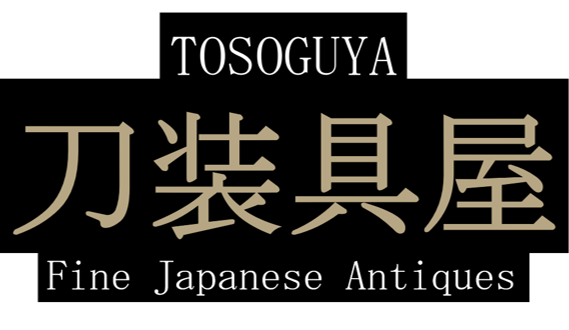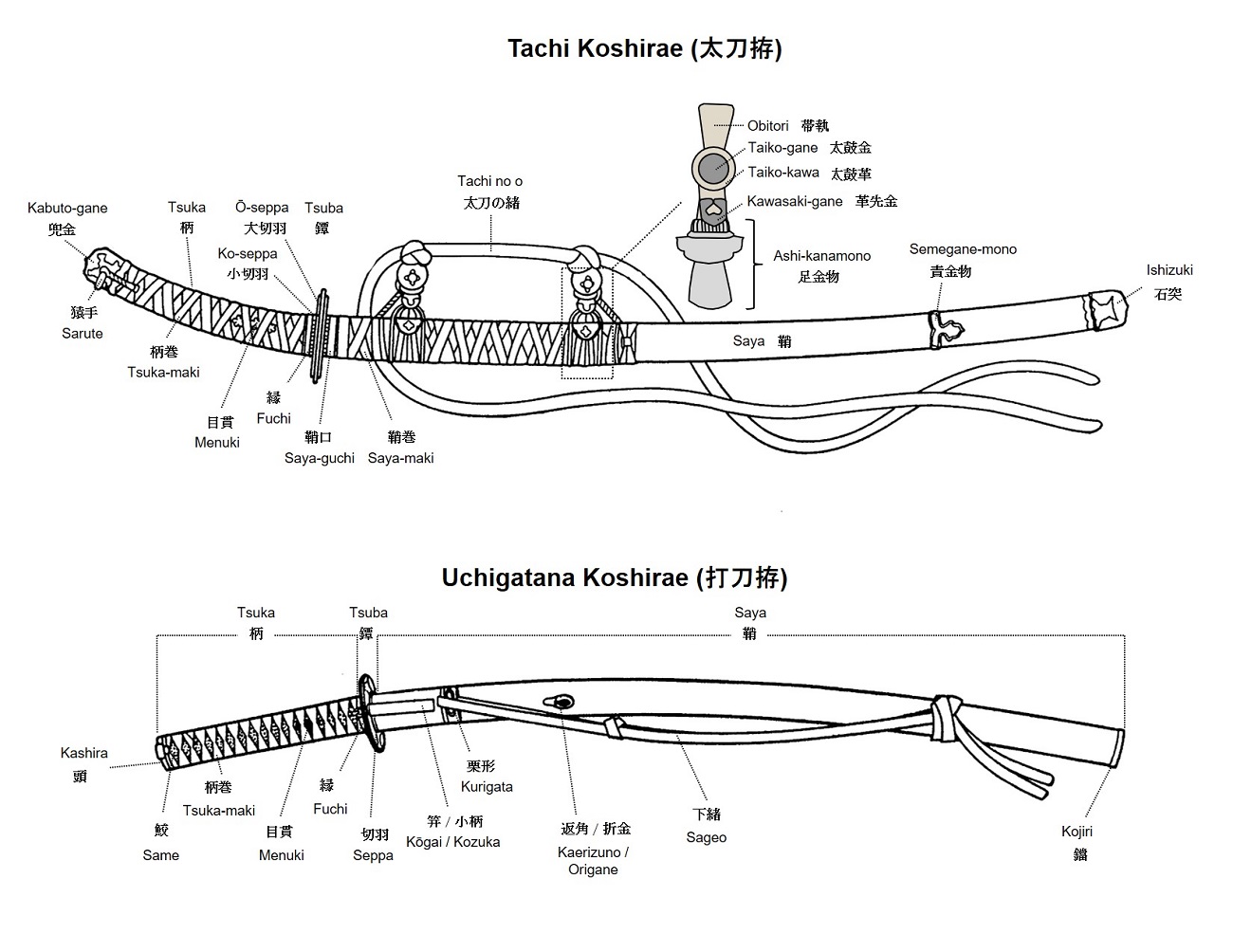

Ashi-kanamono (足金物) - Literally 'foot-fittings', are the hanger fittings which fit over the saya, and affix to the suspension system, or obitori (帯執) of a tachi koshirae. Usually made of two or three components which are soldered together.
Ategane (当て金) - Metal plugs added to tsuba to fill the hitsu-ana. See Tsuba Glossary page
Bori (彫) - General term for surface carving. Prefixed by specific descriptors
Fuchi (縁) - Hilt collar between the tsuba and tsuka
Fukurin (覆輪) - A rim covering, often but not always of soft metal
Gin (銀) - Silver
Habaki (鎺) - The habaki is a wedge shaped metal collar used to keep the sword from falling out of the saya and to support the tsuba and tsuka; fitted at the ha-machi and mune-machi of the blade, which precede the nakago
Hakogaki (箱書) - An attestation, painted onto a storage container
Hirumaki koshirae (蛭巻拵) - Koshirae style where metal bands (typically yamagane) are spirally wrapped around the length of the saya and/or tsuka
Hitsu (櫃) - Pocket in the saya for the kozuka and kōgai
Hitsu-ana (櫃孔) - Opening or passage in the tsuba for purposes of accommodating some object. Respectively prefixed by kanji for kōgai-, kozuka- or nakago- . See Tsuba Glossary page
Inome (猪目) - Heart-shaped design elements, often as sukashi. Literally 'boars eye', in the Japanese design sense. Often added to the plate of Aoi- and Mokkō-gata shaped tsuba, at the apices of the 4 lobes
Ishizuki (石突) - Metal saya end-cap on tachi koshirae. Usually matches the kabuto-gane in style
Itomaki (糸巻 or simply Ito 糸) - Fabric braid wrapping applied to either the tsuka or saya. Ito applies to fabric braid itself, while Maki applies to the wrapped area ie. Tsuka-maki (柄巻) is hilt wrapping; Saya-maki (鞘巻) is saya wrapping
Ji / Shitaji (地 / 下地) - As applied to tosogu, it refers to the ground surface or plate. Usally preceeded by a descriptor ie. Nanako-ji (魚子地); Tetsuji (鉄地)
Kabuto-gane (兜金) - Literally 'helmet metal or fitting'. The end-cap on the tsuka of a tachi koshirae. Equivalent to the kashira
Kaerizuno (返角) - Hook located on the scabbard which secured the sword in the belt sash, preventing it from slipping out. This term is applied to hooks made of horn. When the hook is made of metal, it is called a Origane (折金)
Kairagi-zame (梅花皮鮫) - Refers specifically to the variety of rayskin with the large dermal ossicles insterspreced among the regular ones. Different types are distinguished by the shape of the larger nodes ie. hana-kairagi (花梅花皮, flower-shaped nodes); mame-kairagi (豆梅花皮, bean-shaped nodes), and se-kairagi (脊梅花皮, linear / spine arrangement). Kairagi was much more expensive and rarer than normal same, and a particular red variety called akaeizame (あかえい鮫) was a mainland import
Kamon (家紋) - Traditional Japanese heraldic blazon used to identify clans / families. Often shortened to simply Mon (紋). Note that Mon has other meanings and readings including Mon (文, pattern or design), and Mon (門, school)
Kashira (頭) - Hook located on the scabbard which secured the sword in the belt sash, preventing it from slipping out
Katana (刀) - General term for a sword with a cutting edge measuring over 2 shaku (~60.6cm). Also see Uchigatana
Katachibori (容彫) - Carving method for exposed ornaments ie. menuki, fuchi / kashira, where the subject itself becomes the outline of the menuki. Usually in combination with other techniques such as such as uchidashi. May also be called nikubori or marubori
Kawasaki-gane (革先金) - The decorative metal end-cap on the obitori leather suspension loop
Kin (金) - Gold
Kinkō (金工) - Literally 'gold worker'. General term for soft-metal works
Ko-Kinkō (古金工) - General term for early soft metal works, typically denoting work prior to the Edo period
Kodōgu (小道具) - Literally 'small fittings', denotes all sword fittings excluding the tsuba (also refer to Tōsōgu)
Kōgai (笄) - A personal grooming implement sometimes carried as part of the katana koshirae, in a pocket in the saya
Koiguchi / Sayaguchi (鯉口 / 鞘口) - Koiguichi is literally 'carp mouth', it is the fitting at the opening of the saya. An alternate name is Sayaguchi. Can be a number of materials, though usually is either horn or metal. It can be used in any koshirae, however, in some instances it is not utilized, and the saya end is simply lacquered
Kojiri (鐺 or Sayajiri 鞘尻) - The metal or horn end cap of the saya on non-tachi koshirae. See Ishizuki for tachi.
Koshirae (拵え or simply 拵) - Sword furniture or 'outfit' of a sword

Kozuka (小柄) - The decorative handle fitting of the Kogatana; a small utility knife that was sometimes carried as part of the katana koshirae, in a pocket in the saya
Kurigata (栗形) - Literally 'chestnut shape', it is the fitting on certain koshirae through which a sageo or retention cord was laced
Marubori (全彫) - Literally 'in the round' carving. May also be called nikubori or katachibori
Mekugi (目釘) - The retention peg securing the tsuka to the tang / nakago of a sword
Mekugi-ana (目釘孔) - The hole in the tsuka and nakago for the retention peg securing the tsuka to the nakago of a sword
Mei / Mumei (銘 / 無銘) - Signed / unsigned
Menuki (目貫) - Ornaments mounted on the tsuka in various positions including: under the wrapping (tsuka-ito); directly affixed to the unwrapped same-covered tsuka; or as the ornamental heads of the mekugi pins
Mon - See Kamon
Nanako (魚子) - Literally 'roe'. Tiny punched nodes, arranged in tight combination, typically as a ground ornamentation. See Ji (地)
Nikubori (肉彫) - Carving in 3-dimensions. May be called marubori or katachibori
Obitori (帯執) - Suspension loops attached to the ashi-kanamono of a tachi koshirae. Usually made of leather
Origane (折金) - Hook located on the scabbard which secured the sword in the belt sash, preventing it from slipping out. This term is applied to hooks made of metal. When the hook is made of horn, it is called a Kaerizuno (返角)
Rogin (鑞金) - Copper and silver alloy related to shibuichi, but a lower concentration of copper, higher silver and minor gold
Sageo (下緒) - Cord laced through the kurigata, and used to secure the saya to the obi
Same-gawa (鮫皮 or simply Same 鮫) - The skin of the ray or shark, used to cover the wooden tsuka. The single ridge of larger prominent denticles are called oya-tsubo (親粒), and are considered a determiner of quality of the skin. See Kairagi-zame
Sarute (猿手) - Literally 'monkey hand', it is the ring located inside the kabuto-gane of a tachi, to which a cord might be tied
Saya (鞘) - Scabbard
Sayaguchi (鞘口) - See Koiguchi
Seidō (青銅) - Bronze, an alloy of copper, tin and typically lead. Since originally imported from China, it is also known as karakane (唐金), literally 'China metal'. In its more common yellow form, it can be difficult to distinguish from yamagane. Also see hakudo
Semegane-mono (責金物 or simply semegane 責金) - Metal rings located on the lower ends of tachi and handachi saya. They serve to strengthen the saya, preventing splitting. When the semegane has a protrusion shaped like an oak leaf, it is termed a Kashiwaba (柏葉). Semegane-mono can occur in combination, and it is not uncommon on handachi to find multiple bands
Seppa (切羽) - Spacing washers placed on either side of the tsuba to tighten fit, and/or for ornamental purposes. Variations include smaller ko-seppa (小切羽) and large ō-seppa (大切羽), when mounted in combination
Shakudō (赤銅) - A soft metal alloy composed of copper and gold in amounts ranging from 4-10%. Range of colors from deep black to a dark bronze
Shibuichi (四分一) - A soft metal alloy composed of ~75% copper and 25% silver. Produces a grey patina. See rogin
Shinchū (真鍮 or simply 鍮) - Brass. Variant occasionally seen is Ōdō (黄銅)
Shirasaya (白鞘) - Literally 'white scabbard', it is the plain unlacquered storage mounting for a sword
Shitodome (鵐目) - Decorative metal inserts into the kurigata and/or kashira, through which to thread lacing
Shoki-kinkō (初期金工) - Informal and nebulous term intended to denote 'early period' soft metal works, and originally proposed as a alternative to the terribly named 'Ezo' (蝦夷) school. In this context, it is supposed to denote early stage 'Ezo' works, dating to the Heian and Kamakura periods, but some apply it broadly to early alloys which often don't correlate to modern alloy designations
Sukashi (透) - Openings
Tachi (太刀) - General term for a traditional slung sword, worn edge-down, with a blade length >2 shaku (60.6cm)
Tachi no o (太刀の緒) - Waist belt of the tachi suspension system, which slips through the obitori loops
Taiko-gane / Taiko-kawa (太鼓金 / 太鼓革) - Literally 'drum fitting', this is the metal / leather fitting which serves to pin the obitori loop, allowing the tachi to hang from the tachi-no-o waist belt
Tōsōgu (刀装具) - Sword fittings including the tsuba (also refer to Kodogu)
Tetsuji (鉄地) - Iron ground (also refer to Ji)
Tsuba (鐔 or 鍔) - Hand guard. See Tsuba Glossary page
Tsuka (柄 or 把) - Handle / hilt and associated fittings of a sword
Tsuka-ito (柄糸) - Refers specifically to the lacing which is applied to the hilt
Tsuka-maki (柄巻) - Hilt wrapping, not the lacing itself
Uchidashi (打出) - Repoussé. Hammering from the back to create a positive relief motif when viewed from the front
Uchigatana (打刀) - A general term describing a 'strike-sword'. Similar etymology to the more common term Katana, though an older term, used more to denote swords worn edge-down, with a blade length >2 shaku (60.6cm), from pre-Edo periods
Zugara (図柄) - Motif. Also seen simply as Zu (図)